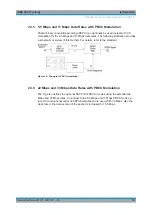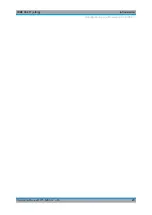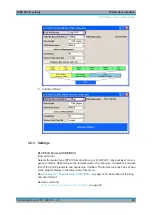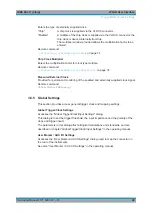
WLAN User Interface
IEEE 802.11 (a/b/g)
33
Operating Manual 1171.5283.12 ─ 18
Remote command:
[:SOURce<hw>]:BB:WLAN:SCRambler:MODE
Service Field Clock Bit (CCK,PBCC)
Sets the locked clock bit in service field of the PLCP header.
Via this flag (bit), the 802.11b/g transmitter indicates whether transmission frequency
and symbol rate have been derived from the same oscillator. If so (locked), the bit is
set to 1, otherwise (not locked) to 0.
Remote command:
[:SOURce<hw>]:BB:WLAN:PLCP:LCBit:STATe
Disable Barker Spreading
(CCK, PBCC)
Activates/deactivates barker spreading (bit rates 1 Mbps or 2 Mbps only).
Remote command:
[:SOURce<hw>]:BB:WLAN:PLCP:LCBit:STATe
Scrambler Init (hex) (OFDM)
Enters the initialization value for scrambling mode User. This value is then identical in
each generated frame.
Remote command:
[:SOURce<hw>]:BB:WLAN:SCRambler:PATTern
Interleaver Active (OFDM)
Activates/deactivates the interleaver.
Remote command:
[:SOURce<hw>]:BB:WLAN:ILEaver:STATe
Service field (hex)
Enters the value of the service field. The standard specifies a default value of 0. Other
values can be entered in hexadecimal form for test purposes or future extensions.
Remote command:
[:SOURce<hw>]:BB:WLAN:SERVice[:PATTern]
Time Domain Windowing Active
Activates/deactivates the time domain windowing.
Time domain windowing is a method to influence the spectral characteristics of the sig-
nal, which is not stipulated by the standard. However, it does not replace oversampling
and subsequent signal filtering.
Remote command:
[:SOURce<hw>]:BB:WLAN:TDWindowing:STATe
Transition Time
Sets the transition time when time domain windowing is active.
The transition time defines the overlap range of two OFDM symbols. At a setting of 100
ns, one sample overlaps.
PPDU/Sequence Configuration
















































